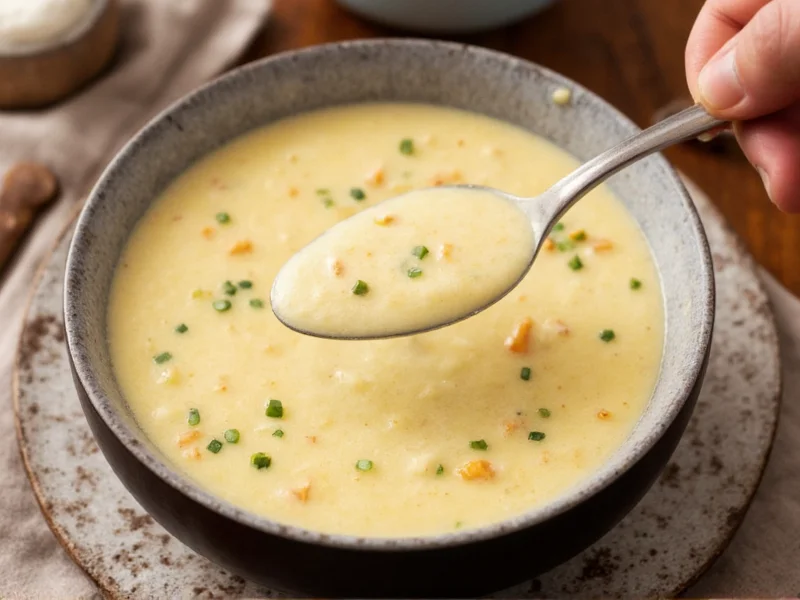The best cream of chicken soup alternatives are homemade versions made with a simple roux (butter, flour, and chicken broth), dairy-free options using coconut milk or cashew cream, and quick pantry substitutes combining milk with cornstarch. These alternatives provide better flavor control, avoid preservatives found in canned versions, and can be customized for gluten-free, dairy-free, or lower-sodium diets while maintaining the creamy texture needed for casseroles and sauces.
When you're staring at a recipe calling for canned cream of chicken soup but want a fresher, healthier option, you're not alone. Many home cooks seek cream of chicken soup alternatives for dietary restrictions, flavor preferences, or simply because they've run out of the canned version. The good news is that creating your own substitute takes just 10-15 minutes and yields superior results for casseroles, sauces, and soups.
Why Make Your Own Cream of Chicken Soup Substitute
Commercial canned versions often contain preservatives, excess sodium, and modified food starches. By making your own cream of chicken soup alternative, you gain complete control over ingredients, can accommodate dietary needs, and create a fresher-tasting base for your favorite recipes. Whether you're preparing a classic chicken pot pie casserole or a comforting broccoli rice bake, these homemade substitutes deliver better texture and flavor.
7 Practical Cream of Chicken Soup Alternatives
1. Classic Homemade Roux-Based Substitute
This traditional method creates the closest texture match to canned cream of chicken soup. The roux-based cream of chicken soup alternative works perfectly in any recipe calling for the canned version.
Ingredients:
- 2 tablespoons butter or olive oil
- 2 tablespoons all-purpose flour (or gluten-free flour blend)
- 1 cup low-sodium chicken broth
- 1/2 cup milk or half-and-half
- 1/4 teaspoon garlic powder
- 1/4 teaspoon onion powder
- Salt and pepper to taste
Instructions:
- Melt butter in a saucepan over medium heat
- Whisk in flour to create a roux, cooking for 1-2 minutes until golden
- Gradually add chicken broth while whisking constantly
- Stir in milk and seasonings
- Cook for 3-5 minutes until thickened to desired consistency
2. Dairy-Free Cream of Chicken Soup Alternative
For those avoiding dairy, this coconut milk-based substitute provides rich creaminess without compromising flavor. This dairy-free cream of chicken soup replacement works surprisingly well in most recipes.
Combine 1 cup unsweetened coconut milk, 2 tablespoons cornstarch, 1 cup chicken broth, and seasonings. Whisk together in a saucepan and cook over medium heat until thickened. Add a teaspoon of nutritional yeast for umami depth if desired.
3. Quick Pantry Substitute (No Cooking Required)
When you need an immediate cream of chicken soup alternative without cooking, try this simple method. This easy cream of chicken soup substitute without canned soup requires minimal ingredients.
Mix 1 cup milk (dairy or plant-based), 2 tablespoons cornstarch, 1 cup chicken broth, and seasonings in a container. Shake vigorously until combined. The cornstarch will thicken the mixture when heated in your recipe.
4. Greek Yogurt and Broth Blend
This high-protein alternative adds tanginess and creaminess. Whisk together 1/2 cup plain Greek yogurt, 1/2 cup chicken broth, 1 tablespoon cornstarch, and seasonings. This healthy cream of chicken soup alternative works best in recipes that will be baked or simmered.
| Alternative Type | Prep Time | Best For | Dietary Notes |
|---|---|---|---|
| Roux-Based | 10-15 minutes | Casseroles, sauces | Gluten-free option available |
| Dairy-Free | 5 minutes | Vegan recipes | Dairy-free, vegan |
| Pantry Quick Fix | 2 minutes | Emergency substitute | Gluten-free option available |
| Greek Yogurt Blend | 5 minutes | Health-conscious cooking | High-protein, lower fat |
How to Use Cream of Chicken Soup Alternatives in Recipes
When substituting homemade versions in recipes, consider these tips for best results:
- For casseroles: Use the roux-based substitute for best binding properties. Add an extra 1-2 tablespoons of broth if your mixture seems too thick.
- For sauces: The dairy-free coconut milk version works well for creamy pasta sauces where the subtle coconut flavor won't interfere.
- For soups: The quick pantry substitute works perfectly as it will thicken further during simmering.
- For gluten-free needs: Replace all-purpose flour with a 1:1 gluten-free flour blend or use cornstarch as the thickener.
Troubleshooting Common Issues
Lumpy texture: Always whisk constantly when adding liquid to the roux. If lumps form, strain the mixture through a fine-mesh sieve.
Too thin: Mix 1 tablespoon cornstarch with 2 tablespoons cold water, then whisk into your substitute and simmer for 2-3 minutes.
Too thick: Gradually add additional broth or milk until desired consistency is reached.
Storage and Shelf Life
Homemade cream of chicken soup alternatives keep well in the refrigerator for 3-4 days. For longer storage, freeze portions in ice cube trays, then transfer to freezer bags. Most substitutes maintain quality for 2-3 months in the freezer. When using frozen substitutes in recipes, add them directly without thawing for best results in casseroles and baked dishes.
Flavor Variations to Try
Customize your cream of chicken soup alternative with these simple additions:
- Add 1 tablespoon white wine for depth in sauces
- Include 1/4 cup pureed mushrooms for earthy notes
- Stir in fresh herbs like thyme or tarragon at the end
- Add a pinch of smoked paprika for subtle complexity











 浙公网安备
33010002000092号
浙公网安备
33010002000092号 浙B2-20120091-4
浙B2-20120091-4